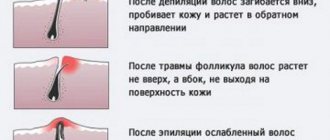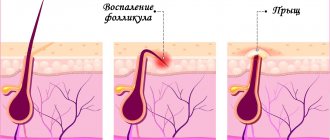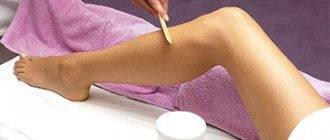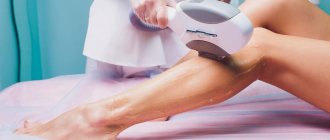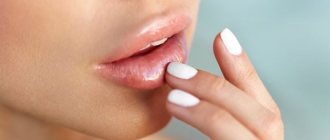Until recently, giving advice of this kind in the press was considered completely indecent. But in vain: life is life, and the vast majority of women - according to statistics, about 80% - are faced with this task in one way or another. Someone just wants to look beautiful everywhere - and there too; For some, excess hair in the bikini area is unhygienic and sloppy; finally, many modern models of underwear and swimsuits do not fit well with the free vegetation in this place.
A lot of hair removal methods have been invented since ancient times - but some are quite painful, while others require the services of an outsider. So the most popular way to deal with unwanted hair in intimate places is still a razor.
The main advantage of shaving, in this case, is that this procedure is painless and easy to perform, requiring minimal skills.
And yet, there are small tricks in this matter that women simply need to know in order to shave in the most delicate places without causing painful skin irritation.
Symptoms of the phenomenon
Depending on the cause of the discomfort, other symptoms appear along with the burning sensation:
- redness of the groin and pubic area;
- peeling of the skin;
- swelling of the external genitalia and pubis;
- unpleasant odor;
- vaginal discharge;
- the appearance of small pimples and purulent boils.
Additional symptoms make the situation even worse and may feel like they are causing the excruciating itching. To quickly get rid of such discomfort and stop itching, you need to correctly determine the cause.
Complications during light hair removal (photo and its varieties)
Despite the modernity and effectiveness of these procedures, side effects are also possible. The reasons may be different: both professional errors of the doctor and non-compliance with recommendations by the patient, as well as his state of health (even despite a thorough history taking before the procedure, there are conditions that the patient himself does not know about). The very first so-called adverse reactions, which may be present normally, are possible after the procedure. This is swelling and hyperemia of the skin, the severity of which depends on the thickness, thickness and color of hair and skin. Typically, these conditions resolve on their own within half an hour after the procedure.
It is not recommended to carry out physiotherapeutic procedures, massages, sunbathing, or visit the pool, saunas and steam baths immediately after hair removal. Since it is possible to provoke the appearance of hyperpigmentation in the treated area.
All complications of photoepilation can be divided into early (manifest within a few days after hair removal) and late (several weeks to a month).
- Early complications include burns, which can occur due to incorrectly selected high energy for the procedure, also during hair removal on very tanned or sensitive skin, and with solar urticaria. In patients suffering from herpes infection, when epilating in the face or deep bikini area, an exacerbation of herpes is possible. Therefore, such patients are advised to take antiviral drugs (acyclovir, famvir, Valtrex) for several days before the procedure. If the procedure technique is not followed (no protective glasses, open eyes), conjunctivitis may develop or visual acuity may decrease. Sometimes after the first procedure, patients complain of single ingrown hairs in the photoepilation area. However, this is not related to the procedure itself. As a rule, if a person removed hair for a long time using wax or sugar, and then decided to switch to light types of hair removal, then a few days before the procedure he had to shave his hair, which led to the appearance of ingrown hairs. In this case, this is a short-term inconvenience that the patient will never encounter again.
- Late complications include hyper- and hypopigmentation, which can mainly form due to non-compliance with doctor’s recommendations, excessive sun exposure, taking photosensitizing drugs, and also after burns on tanned skin. Pigmentation recovers on its own within six months on average. The rarest complication is the possible malignancy of nevi, so any skin formations, especially moles, should be protected from exposure. Any procedure must be approached responsibly.
- Trust your health only to specialists!
Causes of itching on the pubis
The reasons are external and internal. In the first case, you can cope with them on your own, but in the second, you cannot do without professional medical help.
External causes of itching
- Diaper rash
At the initial stage, they do not violate the integrity of the skin and do not cause severe discomfort in the groin area. Only redness and swelling appear. If treatment is not started in a timely manner, painful cracks and abscesses will appear later. There are reasons for the appearance of diaper rash:
- insufficient hygiene, including not changing linen daily;
- excess weight;
- increased skin sensitivity.
Diaper rash usually appears in hot weather, but can occur at any time. To eliminate them, it is necessary to increase the frequency of normal hygiene procedures, eliminate friction with clothing, and use products for newborns, bepanthen, desitin, and streptocidal ointment. If additional care does not produce results and a crack appears, you should rush to the doctor.
- Improper shaving
During depilation, the hair shaft is damaged, then it cannot break through and grows into the epidermis. On the surface of the pubic area in women, small red pimples appear that are very itchy. After applying a soothing gel and temporarily stopping depilation, the discomfort goes away. The main thing is not to scratch the itchy area. To prevent troubles from recurring, you must follow simple rules during the procedure:
- have a personal machine, change cassettes often;
- use shaving gel;
- Direct the movements of the machine according to hair growth.
- Pediculosis
Severe itching on the pubic area is caused by lice. They can appear not only from a sexual partner, but also during other contacts in public places. When they get into the hair, insects multiply quickly, causing great inconvenience, causing irritation and insomnia. To eliminate it, you need to shave your hair, then start treatment. Both partners must sanitize; linen and clothing must be disinfected. Therapeutic drugs are nittifor, xylene, pax, and mercury sulfur ointment.
Video on how to treat lice pubis:
Internal causes of itching
- Purulent acne
With low immunity, a cold, in stressful situations and during anxiety, purulent pimples may appear, which cause itching in the pubic area. Men and women are susceptible to this. To open the ulcers, you need to apply ointments (ichthyol and Vishnevsky), make lotions from a solution of potassium permanganate, a decoction of herbs from celandine and chamomile. Be sure to take vitamins, sedatives, and eat more fruits and vegetables.
- Allergic reaction
An allergic reaction can occur to the material of underwear, some components of intimate hygiene products, panty liners, and medications. An accompanying symptom is usually swelling. To eliminate itching and get rid of it completely, it is enough to remove the cause of the irritation and treat the pubis with a soothing gel or cream. Once the cause is established, the use of the stimulus cannot be repeated.
- Genital herpes
The cause of itching on the pubic area in women and men can be viral genital herpes. An accompanying symptom is a watery, fine rash. The blisters burst over time, and the ulcers formed in their place itch and cause discomfort. Then the visual manifestation of the disease disappears, it goes into a “dormant state.” You can get infected from a sexual partner, even if he has herpes on his face. For many people, the causative agent of the virus lies dormant in the body and appears only when the immune system is weakened, hormonal changes, or a cold. To treat the disease, the doctor prescribes antiviral, anti-inflammatory and immunomodulating agents.
- Molluscum contagiosum
The pubic area may itch due to molluscum contagiosum. It does not develop in the genitals, so it is transmitted through normal contact. It also appears due to disruptions in the hormonal system, insufficient hygiene, and after depilation. In addition to itching, large pink pimples with a shiny crust appear on the pubic area. They do not hurt, but when pressed they release a white mass. It is best to remove mollusks on an outpatient basis, followed by cauterization with an alcohol solution. Viferon and acyclovir ointments give good results. To completely eliminate the problem, your doctor may suggest a laser procedure.
Video on the topic:
- Psoriasis
Psoriasis affects many areas of the skin, including the pubic area. Symptoms include severe itching, redness and flaking. Papules may appear. You can get rid of itching only with complex treatment. Ointments and lotions, compresses from decoctions of medicinal herbs are used externally. The disease is difficult to cure, and a temporary decline is then replaced by an exacerbation. When the first symptoms appear, you should immediately contact a dermatologist. The faster he diagnoses the cause and prescribes treatment, the higher the likelihood of a complete recovery.
- Fungal diseases
Candida lives in the body constantly and does not cause discomfort until a certain point. The fungus is activated by immunodeficiency, hormonal changes, endocrine diseases, problems with the digestive system, and promiscuity. Symptoms are itching on the pubis, swelling and discharge from the vagina in the form of a curd mass in girls, in men a burning sensation on the head of the penis, a white coating in the frenulum area, the appearance of cracks, and a white sediment in the urine. Pain during urination and discomfort during sexual intercourse are possible. Antifungal drugs clotrimazole, fluconazole, nystatin, flucostat, betadine, gynoflor, ginesol, diflucan are suitable for treatment; douching with soda solution helps. Both partners need to be treated at the same time, even if only one is itching in the pubic area. Be sure to take vitamin complexes to strengthen your immune system.
You cannot prescribe pharmaceuticals yourself. The shorter the course of treatment, the healthier other organs, in particular the liver, will remain.
- Sexually transmitted diseases and infections
Trichomoniasis, gonorrhea, syphilis, chlamydia and other sexually transmitted diseases can appear only 2 months after sexual contact with a sick partner or a carrier of the virus. Swelling, itching in the groin area in women, redness, and purulent gray-green discharge appear. Treatment requires antibiotics, anti-inflammatory drugs, antihistamines, and immunomodulators. You cannot try to get rid of the disease on your own, because it can become chronic. Outpatient or inpatient treatment will still be needed, but it will be much more difficult and more expensive.
After the procedure
You need to secure the result of an intimate shave with a softening cream or gel - your favorite product that nourishes the skin. And for the first half hour after shaving, it’s better to go without any underwear at all - let the skin breathe, so it will be less injured. After shaving your bikini area, it is better to wear panties made of natural fabric - for the same reasons. More ventilation means less irritation and redness.
As you can see, the technology is quite simple, although it requires careful attention. But this is precisely the quality that women have always lacked - and therefore, to this day, shaving remains one of the main methods of depilation of the intimate area. Once you have learned this, you can carry out this procedure almost with your eyes closed. And most importantly, if you follow the simple rules described above, shaving will be completely painless.
Traditional methods of treatment
The above remedies will help relieve itching
If there are external causes of itching, you should not rub the skin until it bleeds, but try to help yourself.
- Treat acne with a weak solution of potassium permanganate, soda, herbal decoctions, furatsilin, hydrogen peroxide.
- Apply aloe leaves after cutting them to improve the flow of juice. You can apply a gauze strip soaked in aloe juice or Vishnevsky ointment to the inflamed area, securing it with a “breathable” plaster.
- Douche with soda solution (1 teaspoon per liter of water) 3 times a day.
- Take vitamins, royal jelly in capsules or tablets.
- Include more vegetables, fruits, berries, juices in your diet, exclude fast food, fatty foods, and alcohol.
During treatment procedures, do not depilate, because this can only aggravate the discomfort. This does not apply to lice, in which hair removal is the first step in treating the disease.
Complications of electrolysis
Of course, electrolysis is ideal for removing single hairs, as well as very light and gray hairs that are not amenable to light types of hair removal. But the procedure is invasive, and therefore requires strict rules of asepsis and antisepsis, and is also very painful, often requiring anesthesia. After the procedure, some of the earliest side effects are swelling and pastiness, requiring the use of soothing creams and gels. Swelling can last up to 48 hours. Crusts may also form after electrolysis. If the procedure is carried out carelessly, hemorrhage may develop if the conductor extends beyond the hair follicle and can damage adjacent and deeper vessels. Therefore, this procedure is not recommended during menstruation and in patients with bleeding disorders.
Also, with an unprofessional specialist approach to electrolysis, infection is possible, which must be subjected to appropriate treatment. More long-term consequences include hyper- and hypopigmentation in places where the crusts have faded, which can last up to 6-9 months. Pigmentation usually recovers on its own; lightening creams can be used. Since the procedure is invasive, wounds are formed that can heal with the formation of scars. Therefore, this type of hair removal is contraindicated in patients with a tendency to keloid scars. Electrolysis, unfortunately, is also not without such drawbacks as ingrown hairs.
Complications of various types of hair removal
| shaving | wax | threads | sugaring | electro | photo | A.F.T. | laser | |
| irritation | ++++ | +++ | ++++ | ++ | ++++ | — | — | — |
| crusts | ++ | ++ | ++ | + | ++++ | ++ | + | — |
| ingrown hairs | ++++ | +++ | +++ | — | — | — | — | — |
| scars | — | + | + | + | +++ | + | — | — |
| burns | — | +++ | — | + | — | ++ | + | — |
| hypo- and hyperpigmentation | — | ++ | — | +++ | ++ | + | + | — |
| edema | — | + | + | — | +++ | + | + | — |
| frequency of procedures | 1 Week | 2 weeks | 2 weeks | 2 weeks | Once every 4-5 years* | Once a year* | Once a year* | Once a year* |
* - supporting procedures necessary after completing a one-time course
Author of the material: Dermatologist, cosmetologist N.M. Lachinova. All rights reserved.



